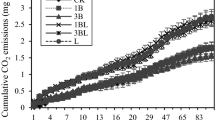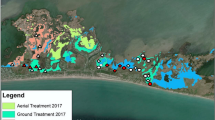Summary
The effects of spraying secondary-treated wastewater on a young pine forest were studied in South Carolina, U.S.A. Soil, herb-shrub layer vegetation and arthropods were analyzed in control, low-spray and high-spray areas to determine the overall impact of four years of chronic nutrient and water enrichment. Spraying had no significant effect on soil organic matter and cation exchange capacity. Soil cation buildups did not occur and cation leaching was evident.
Wastewater application produced a more mesic environment and the herb-shrub layer vegetation shifted to an earlier stage in succession. Plant diversity decreased significantly as a few rapidly-growing opportunistic species (e.g., Erechtites hieracifolia, Polygonum pensylvanicum) replaced the more diverse perennial herbshrub layer vegetation of the pine forest. Peak vegetation biomass levels doubled and net primary production rates were 10 times greater in high spray areas. Litter biomass levels, however, did not change significantly. Litter decomposition rates were significantly greater in treated areas which apparently offset the added litter resulting from increased plant production.
Arthropod production increased 3-fold in treated areas. All herbivore guilds had higher biomasses that reflected seasonal changes in producer phenology. Total arthropod diversity increased despite the lower vegetation diversity in spray areas. Arthropod diversity apparently increased because of greater resource availability in treated areas.
Similar content being viewed by others
References
Bakelaar RG, Odum EP (1978) Community and population level responses to fertilization in an old-field ecosystem. Ecology 59:660–665
Benke AA (1976) Dragonfly production and prey turnover. Ecology 57:915–927
Black CA, (ed) (1965) Methods of Soil Analysis, I. American Society of Agronomy Madison
Bokhari VG, Dyer MI, Singh JS (1974) Labile and nonlabile energy in blue grama (Bouteloua gracilis) as influenced by temperature, water stress, and fertilizer treatments. Can J Bot 52:2289–2298
Caswell H, Reed F, Stephenson SN, Werner PA (1973) Photosynthetic pathways and selective herbivory: A hypothesis. Amer Natur 107:465–480
Cates RG, Orians GH (1975) Successional status and the palatability of plants to generalized herbivores. Ecology 56:410–418
Chadwick MJ, Edworthy KJ, Rush D, Williams PJ (1974) Ecosystem irrigation as a means of groundwater recharge and water quality improvement. J Appl Ecology 11:231–248
Day AD, Taher FA, Katterman FRH (1975) Influence of treated municipal wastewater on growth, fiber, acid-soluble nucleotides, protein, and amino acid content in wheat grain. J Environ Qual 4:167–169
Dixon WJ, Massey FJ (1969) Introduction to Statistical Analysis. McGraw-Hill Inc, New York
Evans JO (1970) The soil as a resource renovator. Environ Sci Technol 4:732
Golley FB (1965) Structure and function of an old-field broomsedge community. Ecol Monogr 35:113–137
Goodland R, Pollard R (1973) The Brazilian Cerrado vegetation: a fertility gradiont. J Ecol 61:219–224
Grime JP (1979) Plant Strategies and Vegetation Processes. John Wiley & Sons New York
Harcombe PA (1977) The influence of fertilization on some aspects of succession in a humid tropical forest. Ecology 58:1375–1383
Hill DW (1974) Use of municipal wastewater and sludge on agricultural land. In: MC Blount (ed) Water Resources Utilization and Conservation in the Environment. Proceedings of the Southeast Region Water Resources Symposium, Fort Valley, Georgia U.S.A. 28 Feb.-1 Mar., Fort Valley State College. p 242–264
Hinesly TD, Jones RL, Tayler JJ, Ziegler EL (1976) Soybean yield responses and assimilation of Zn and Cd from sewage sludgeamended soil. J Water Pollut Control Fed 48:2137–2153
Horn HS (1974) The ecology of secondary succession. Annu Rev Ecol Syst 5:25–37
Hurd LE, Wolf LL (1974) Stability in relation to nutrient enrichment in arthropod consumers of old-field successional ecosystems. Ecol Monogr 44:465–482
Hunt EJ (1977) Vegetation and arthropod responses to chronic wastewater application in a pine forest. Atlanta, Georria U.S.A.: M.S. thesis, Emory University
Keever C (1950) Causes of succession of old fields of the Piedmont North Carolina. Ecol Monogr 20:229–250
Kelling KA, Walsh LM, Peterson AE (1976) Crop responses to tank truck application of liquid sludge. J Water Pollut Control Fed 48:2190–2197
Kirchner TB (1977) The effects of resource enrichment on the diversity of plants and arthropods in a short-grass prairie. Ecology 58:1334–1344
Lejcher TR, Kunkle SH (1973) Restoration of acid spoil banks with treated sewage sludge. In: Recycling Treated Municipal Wastewater and Sludge through Forest and Cropland, WE Sopper and LT Kardos (eds), Pennsylvania State University Press University Park, Pa p 184–199
Manson RJ, Merrit CA (1975) Land application of liquid municipal wastewater sludges. J Water Pollut Control Fed 47:20
Mathews CP, Westlake DF (1969) Estimation of production by populations of higher plants subject to high mortality. Oikos 20:156–160
Mathews CP (1970) Estimates of production with reference to general surveys. Oikos 21:129–133
Mayer PG, Palms JM, Platt RB, Ragsdale HL, Shure DJ (1973) The Environmental Monitoring Program for the Allied-Gulf Nuclear Fuel Reprocessing Plant. An Interpretive Report for the First Three Preoperational Years. Rpt. #EMP-113. Atlanta: Emory University
Mellinger MV, McNaughton SJ (1975) Structure and function of successional vascular plant communities in central New York. Ecol Monogr 45:161–182
Milner C, Hughes RE (1968) Methods for Measurement of the Primary Production of Grassland. IBP Handbook No. 6. Blackwell Publishers Oxford
Murdoch WW, Evans FC, Peterson CH (1972) Diversity and pattern in plants and insects. Ecology 53:819–829
Nees J, Dugdale RC (1959) Computation of production for populations of aquatic midge larvae. Ecology 40:425–430
Nicholson SA, Monk CD (1974) Plant species diversity in old-field succession on the Georgia Piedmont. Ecology 55:1075–1085
Nicholson SA, Monk CD (1975) Changes in several community characteristics associated with forest formation in secondary succession. Am Midl Nat 93:302–310
Nutter WL, Schultz RC Brister GH (1975) Unpublished data.
Odum EP (1960) Organic production and turnover in old field succession. Ecology 41:34–49
Odum EP (1969) The strategy of ecosystem development. Science 164:262–270
Olson JS (1958) Rate of succession and soil changes on southern Lake Michigan sand dunes. Bot Gaz 119:125–170
Olson JS (1963) Energy storage and the balance of producers and decomposers in ecological systems. Ecology 44:322–331
Ovington JD (1965) Quantitative ecology and the woodland ecosystem concept. Adv Ecol Res 1:103–191
Radford AE, Ahles HE, Bell CR (1968) Manual of the Vascular Flora of the Carolinas. Chapel Hill: University of North Carolina Press
Reed FCP (1977) Plant species number, biomass accumulation, and productivity of a differentially fertilized Michigan old field. Oecologia (Berl) 30:45–53
Root RB (1973) Organization of a plant-arthropod association in simple and diverse habitats: the fauna of collards (Brassica oleracea). Ecology 43:95–124
Schmidt CJ, Kugelman I, Clements EV III (1975) Municipal wastewater reuse in the United States. J Water Pollut Control Fed 47:2229–2245
Sopper WE (1971) Disposal of municipal waste water through forest irrigation. Environ Pollut 1:263–284
Sopper WE, Kardos LT (1973) Vegetation responses to irrigation with treated municipal wastewater. In: WE Sopper and LT Kardos (eds), Recycling Treated Municipal Wastewater and Sludge through Forest and Cropland. Pennsylvania State University Press University Park Pa
Southwood TRE (1966) Ecological Methods, with Particular Reference to the Study of Insect Populations. Methuen London
Tramer EJ (1975) The regulation of plant species diversity on an early successional old-field. Ecology 56:905–915
Urie DH (1973) Phosphorus and nitrate levels in ground water as related to irrigation of Jack pine with sewage effluent. In: WE Sopper and LT Kardos, (eds) Recycling Treated Wastewater and Sludge through Forest and Cropland. Pennsylvania State University Press University Park, Pa. p 176–183
Waloff N, Solomon MG (1973) Leafhoppers (Auchenorrhynca: Homoptera) of acidic grassland. J Appl Ecol 10:189–212
Waters TF (1969) The turnover ratio in production ecology of freshwater invertebrates. Amer Natur 103:173–185
Winer BJ (1971) Statistical Principles in Experimental Design. McGraw-Hill, Inc New York
Witkamp M (1971) Soils and components of ecosystems. Annu Rev Ecol Syst 6:85–110
Wolfe JA (1962) Analytical Procedures for Plant and Soil Samples. University of Tennessee Knoxville
Young CE, Carlson GA (1975) Land treatment versus conventional advanced treatment of municipal wastewater. J Water Pollut Control Fed 17:2565–2573
Author information
Authors and Affiliations
Rights and permissions
About this article
Cite this article
Hunt, E.J., Shure, D.J. Vegetation and arthropod responses to wastewater enrichment of a pine forset. Oecologia 47, 118–124 (1980). https://doi.org/10.1007/BF00541786
Received:
Issue Date:
DOI: https://doi.org/10.1007/BF00541786




